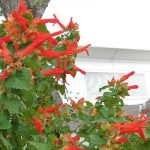To keep or not to keep: that is the question every homeowner must answer themselves when it comes to ash juniper in the landscape.
Growing up in the Hill Country, I still refer to ashe juniper, Juniperus ashei as “cedar.” But this native and ubiquitous tree is not a true cedar at all. In fact, it’s of the genus Juniperus, not the genus Thuja that true cedars belong to.
When early European settlers traveled through the New World, they called this evergreen “cedar” because it resembled the cedar trees of their homeland. Another interesting fact about this tree is that it was not nearly as common as it is today. Think back to the days of the American bison, when grassland fires burned every few years and grasslands dominated much of the state. European settlers discouraged fire on the land and since then there has been an increase in trees and shrubs.
The grasslands of Central North America have been replaced with homes, parking lots, agricultural fields and lots of trees. This has greatly altered the landscape in favor of woody vegetation and has negatively affected historically native plant communities in such a way that grassland-dependent wildlife is having trouble surviving.
Cedar, I mean, juniper has always existed in North America, but it was not until the last several hundred years that it has become something of a pest. In the past, juniper in Texas was restricted to canyons of the Hill Country where it was relatively safe from fire. Young saplings that sprung up in prairies and savannahs were not allowed to mature due to naturally occurring fire. Young juniper is intolerant of fire, but native grasses and forbs quickly recover from recent burns.
So, are juniper trees good or bad? Well, the answer is not so simple. If my property was covered in cedar I’d be very careful not to bulldoze or scrape the land because of the risk of erosion. Erosion is worse than any undesirable plant species. It takes many years for soil to build, some say 50 years to produce half an inch of soil! Removing juniper will cause erosion because it leaves behind bare soil.
Bare soil exposed to wind and rain is quickly lost and it takes with it vital nutrients and dormant, but viable native seed. I would suggest thinning a little here or there, allowing the native grasses to grow in and then thinning a little more. Little by little, it can be removed from your property, but you want to make sure that your native bunch grasses are growing in nice and thick.
You may want to supplement with native grass seed from a local and reputable source. Native grasses such as little bluestem, big bluestem, Indian grass, sideoats grama and eastern gamagrass have extensive root systems that stabilize soil, keeping it where you want it and actually encouraging groundwater infiltration, promoting a healthy water table. Avoid non-native grasses such as KR bluestem that are shallow-rooted and discourage healthy, diverse ecosystems as they tend to displace native plants and form monocultures.
There are some benefits of having ashe juniper.
- Dense foliage provides cover for wildlife.
- Juniper is a very drought tolerant and evergreen shade tree, perfect for a privacy screen.
- Berries provide food for cedar waxwings and the American robin, both beautiful songbirds.
- The stringy bark of mature juniper provides nesting material for the federally endangered golden-cheeked warbler, another beautiful songbird that reproduces only in the Texas Hill Country.
- Female trees produce blue berries that are quite lovely and do not produce the allergenic pollen of the male trees.
- It acts as a “nursery tree” providing shade for young, tender saplings of highly desirable trees and shrubs such as the Texas madrone (Arbutus xalapensis), which is considered one of the most beautiful of native Texas trees.
On other hand, don’t forget the detriments of ashe juniper.
- Thick canopy has large surface area that can intercept rainfall and may evaporate shortly after the rain is over. This greatly discourages groundwater infiltration.
- It easily outcompetes native grasses and forbs that were once dominant in our region several hundred years ago.
- Male trees produce pollen that can trigger allergic reactions in humans.
- While the presence of this tree may provide benefit for some native bird species, other grassland wildlife that once was abundant in this area is now without suitable habitat.
Each homeowner must seek out what works best for their specific situation. You can clear it all over time in an effort to restore grassland habitat to central Texas. Or you can clear some while leaving others that provide privacy and/or food for wildlife. Or you may decide not to remove any at all. It’s up to you.




